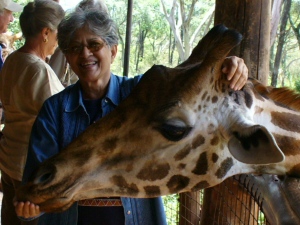 Two friends of mine died very suddenly, or at least the news of their passing hit me abruptly, and in a way that has made it impossible to say goodbye. Time, distance, but mostly the tenuousness of the connections in addition to the transience of being…
Two friends of mine died very suddenly, or at least the news of their passing hit me abruptly, and in a way that has made it impossible to say goodbye. Time, distance, but mostly the tenuousness of the connections in addition to the transience of being…
Two days ago, Meera Kosambi died. A newspaper reported (I have made very minor editorial changes) that “Noted sociologist Meera Kosambi, the younger daughter of the great historian and mathematician D. D. Kosambi, passed away at a private hospital in Pune on Thursday after a brief illness. She was 75.
Ms. Kosambi, who did not marry, had an illustrious pedigree. Her father, a polymath, was India’s pre-eminent Marxist historian, while her grandfather was the renowned Buddhist scholar and Pali language expert, Acharya Dharmananda Damodar Kosambi.
Ms. Kosambi did her Ph.D. in sociology from the University of Stockholm. She wrote, co-wrote or edited more than 15 books which reflected a lifelong preoccupation and passion for the notion of the modern, emancipated Indian woman. While all her works are shot through with brilliant and incisive scholarship, Ms. Kosambi’s crowning achievement was to turn the light on Pandita Ramambai, the great 19th century Indian reformer and educationist and early pioneer of women’s emancipation in India.
 Through her splendid translations of Returning the American Gaze: Pandita Ramabai’s The people of the United States (1889) and a volume of Ramabai’s Selected Works, Ms. Kosambi was instrumental in salvaging the great reformer’s reputation from the debris of time and restoring Pandita Ramabai to the pedestal of one of Modern India’s most illustrious figures. A wide-ranging writer and intellectual, she authored numerous essays and books on topics ranging from Marathi theatre to the social ecology of Mumbai.”
Through her splendid translations of Returning the American Gaze: Pandita Ramabai’s The people of the United States (1889) and a volume of Ramabai’s Selected Works, Ms. Kosambi was instrumental in salvaging the great reformer’s reputation from the debris of time and restoring Pandita Ramabai to the pedestal of one of Modern India’s most illustrious figures. A wide-ranging writer and intellectual, she authored numerous essays and books on topics ranging from Marathi theatre to the social ecology of Mumbai.”
I got to know Meeratai- and she insisted that I call her that- in course of my attempts to reconstruct the D D Kosambi mathematical oeuvre about five years ago. Introduced on email by Romila Thapar, I addressed her once as Meera, inviting her immediate reprimand. Subsequently, after many meetings in many cities, including a memorable lunch at Malaka Spice in Koregaon Park in Pune, and a unexpected visit of hers to the University of Hyderabad, I got to know some of the many personae of Meera Kosambi.
There is much I am grateful to Meeratai for. The opportunity to rifle through a big box containing some of DDK’s papers, the many anecdotes of her father and grandfather, sharing her ongoing work, the books she was writing and so much more. (The papers have been digitized and the originals are now kept in the NMML.) Once when I was telling her I was planning to visit the Kelkar Museum in Pune, she told me to look out for Anandibai Joshee’s quilt– something I would have missed for sure. There was a book she was planning on Anandibai, to set the record right on the person she really was. Although this will now not happen, there is some small consolation that Meeratai did help with the chapter on Anandibai in The Girl’s Guide to a life in Science.
I’m particularly glad that I was able to show her the essays I had written on her father’s mathematical contributions. She admired these (the fundamental and important contributions, that is) greatly without being able to understand much (or any) of the mathematics, and over many conversations I tried to explain some of it. I’m not sure that it got through, but I was very pleased that she included one of the essays in her book “Unsettling the Past: Unknown Aspects of D D Kosambi”. She was to have come to Delhi last year when I spoke at the Nehru Memorial Museum on Kosambi’s mathematics, but a minor illness made it difficult for her to travel then. A month or so later I saw her briefly, the last time.
In the end, her final illness drew a very abrupt curtain- no time for goodbyes, or even to thank her for her exceptional generosity. And given that she was the last of the Kosambis, there is nobody but other friends to reach out to, but it is not enough…
The abruptness of Meeratai’s passing reminded me again of Esther Liberman, a friend of many years who I first met when she came to India in the early 1970’s on a summer trip for social science teachers. She was a schoolteacher in a private school in New York. I kept the connection when I was a graduate student in Princeton- and during many visits over many weekends when I got to know her better, and her husband Gil and her beloved dachshund… Esther and Gil lived in a great apartment on Riverside Drive in New York, were archetypically liberal and opinionated, and were great for a discussion on just about anything, from (in those days) Ronald Regan‘s presidency to Disco Sally (both whom they reviled). When George Bush became President she declared her intention to retire in India and I believe she was even half serious about it- by that time she had gained a lot of friends here on many visits.
 One Sunday afternoon in 1998 or thereabouts the both of them were killed in a freak car accident. Esther died on the spot and Gil a few days later, a speeding car coming the opposite direction jumped the divider and had banged into them. I heard about it a few days later, and by that time it was truly all over. They had no children, no surviving relatives, and since they lived in another world, there was nobody to share the sorrow of their passing with. For many years thereafter I felt unable to even visit New York, my sense of the city was so tied up with Esther and the many shared experiences. Lunch at Chanterelle. A visit to Sloan-Kettering when Gil was operated for oral cancer. The Met. MOMA. A visit to see her aged mother in a nursing home. Schindler’s Ark. A walk in Central Park…
One Sunday afternoon in 1998 or thereabouts the both of them were killed in a freak car accident. Esther died on the spot and Gil a few days later, a speeding car coming the opposite direction jumped the divider and had banged into them. I heard about it a few days later, and by that time it was truly all over. They had no children, no surviving relatives, and since they lived in another world, there was nobody to share the sorrow of their passing with. For many years thereafter I felt unable to even visit New York, my sense of the city was so tied up with Esther and the many shared experiences. Lunch at Chanterelle. A visit to Sloan-Kettering when Gil was operated for oral cancer. The Met. MOMA. A visit to see her aged mother in a nursing home. Schindler’s Ark. A walk in Central Park…
There was so much more. Esther was the first to tell me about the small world phenomenon, the six-degrees-of-separation in a characteristically Esther way, “Ram, there are only 800 people in the world!”. The mathematical model, which came some years later, basically amplified this idea, that we each tend to know about a thousand people, so with a world population of a few billion, it takes no more than six links to connect any two people. But in the end, even the links were not that many.
The last time we met with Esther was at the Railway Hotel in Puri, eating jam roly-poly. And a few months later, she was gone, and I have had no occasion to grieve, nothing to mark the passing of a dear friend except for an empty feeling that there should be something more than just this.

